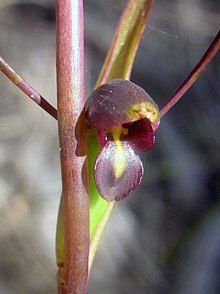| Diurideae | |
|---|---|

| |
| Orthoceras strictum | |
| Scientific classification | |
| Kingdom: | Plantae |
| Clade: | Tracheophytes |
| Clade: | Angiosperms |
| Clade: | Monocots |
| Order: | Asparagales |
| Family: | Orchidaceae |
| Subfamily: | Orchidoideae |
| Tribe: | Diurideae (Endl.) Lindl. ex Meisn., Pl. Vasc. Gen.: Tab. Diagn. 387, Comm. 289. (1842) |
| Type genus | |
| Diuris Sm.
| |
| Subtribes | |
Diurideae is a tribe of orchid in the subfamily Orchidoideae. It contains about 40 accepted genera.[1] As of April 2018[update], its division into subtribes remained unclear.
Genera
[edit]Chase et al. (2015) accepted the following genera.[1] Some have since been combined.
- Acianthus R.Br.
- Adenochilus Hook.f.
- Aporostylis Rupp & Hatch
- Arthrochilus F.Muell.
- Burnettia Lindl.
- Caladenia R.Br.
- Caleana R.Br.
- Calochilus R.Br.
- Chiloglottis R.Br.
- Coilochilus Schltr.
- Corybas Salisb.
- Cryptostylis R.Br.
- Cyanicula Hopper & A.P.Brown = Caladenia[2]
- Cyrtostylis R.Br.
- Diuris Sm.
- Drakaea Lindl.
- Elythranthera (Endl.) A.S.George
- Epiblema R.Br.
- Ericksonella Hopper & A.P.Br.
- Eriochilus R.Br.
- Genoplesium R.Br.
- Glossodia R.Br.
- Leporella A.S.George
- Leptoceras (R.Br.) Lindl.
- Lyperanthus R.Br.
- Megastylis (Schltr.) Schltr.
- Microtis R.Br.
- Orthoceras R.Br.
- Paracaleana Blaxell = Caleana[3]
- Pheladenia D.L.Jones & M.A.Clem.
- Praecoxanthus Hopper & A.P.Brown
- Prasophyllum R.Br.
- Pyrorchis D.L.Jones & M.A.Clements
- Rhizanthella R.S.Rogers
- Rimacola Rupp
- Spiculaea Lindl.
- Stigmatodactylus Maxim. ex Makino
- Thelymitra J.R.Forst. & G.Forst.
- Townsonia Cheeseman
- Waireia D.L.Jones
References
[edit]- ^ a b Chase, M.W.; Cameron, K.M.; Freudenstein, J.F.; Pridgeon, A.M.; Salazar, G.; van den Berg, C. & Schuiteman, A. (2015), "An updated classification of Orchidaceae", Botanical Journal of the Linnean Society, 177 (2): 151–174, doi:10.1111/boj.12234
- ^ "Caladenia". World Checklist of Selected Plant Families (WCSP). Royal Botanic Gardens, Kew. Retrieved 2018-04-15.
- ^ "Paracaleana". World Checklist of Selected Plant Families (WCSP). Royal Botanic Gardens, Kew. Retrieved 2018-04-15.
Well, that’s interesting to know that Psilotum nudum are known as whisk ferns. Psilotum nudum is the commoner species of the two. While the P. flaccidum is a rare species and is found in the tropical islands. Both the species are usually epiphytic in habit and grow upon tree ferns. These species may also be terrestrial and grow in humus or in the crevices of the rocks.
View the detailed Guide of Psilotum nudum: Detailed Study Of Psilotum Nudum (Whisk Fern), Classification, Anatomy, Reproduction